#1866 gown
Photo

La Mode illustrée, no. 2, 7 janvier 1866, Paris. Toilettes de Melle Raboin, 67 r Nve des Pts. Champs. Coiffures de Mr Croizat, 76 rue de Richelieu. Ville de Paris / Bibliothèque Forney
Description de toilettes:
Robe de satin blanc, à jupe très-large et très-longue, avec queue arrondie; sur le bord inférieur se trouve une bande de velours vert, coupée en biais,' à dents très-larges à la base, et très-pointues, garnies avec une ruche de dentelles noires et blanches, qui ont au pied une rangée de perles de cristal. Sur chaque couture de la robe, un petit biais de velours vert, garni de chaque côté avec une dentelle blanche très-étroite, posée sur un fond de tulle noir. Corselet de velours vert, découpé sur ses borde (supérieur et inférieur), et garni comme le biais de la jupe. Corsage blanc en mousseline, à draperies et petites dentelles noires; le haut est liséré de velours vert et d'un rang de perles de cristal.
Robe de velours rubis en forme de tunique princesse, très-longue et très-large. Une bande de chinchilla figure la tunique par devant, et remonte en angles sur deux des coutures des lés de chaque côté du devant; la robe et les coutures des lés (contenues entre les bandes de chinchilla) sont garnies de boutons en filigrane d'or. Corsage montant, sur lequel le chinchilla simule des revers; les manches sont composées de bandes de velours en forme de vis, entrecoupées de bouillonnés de satin; épaulettes et bas de manches en chinchilla.
—
Dress of white satin, with very wide and very long skirt, with rounded tail; on the lower edge is a strip of green velvet, cut on the bias, with very wide teeth at the base, and very pointed, trimmed with a ruffle of black and white lace, which has at the foot a row of pearls of crystal. On each seam of the dress, a small bias of green velvet, trimmed on each side with a very narrow white lace, placed on a background of black tulle. Corselet of green velvet, cut on its edges (upper and lower), and trimmed like the bias of the skirt. White muslin bodice with draperies and small black laces; the top is trimmed with green velvet and a row of crystal beads.
Ruby velvet dress in the form of a princess tunic, very long and very wide. A strip of chinchilla appears on the tunic in front, and goes up in angles on two of the seams of the strips on each side of the front; the dress and the seams of the strips (contained between the chinchilla bands) are trimmed with gold filigree buttons. Rising bodice, on which the chinchilla simulates lapels; the sleeves are composed of strips of velvet in the form of screws, interspersed with swirls of satin; Chinchilla shoulder pads and cuffs.
#La Mode illustrée#19th century#1800s#1860s#1866#periodical#fashion#fashion plate#color#retouch#description#Forney#dress#satin#toilette#ensemble#Raboin#Croizat#gown#ball#evening#princess#velvet#ruby#chinchilla
154 notes
·
View notes
Text

Everyone's getting excited about 1960s ineffable wives but what about 1860s instead
#this was a speedpaint except it took a while longer than those tend to#anyway i did trace the faces and arms/necks from references#so i can't take credit for those looking like that#just wanted to crank this out#symbollism/costume details to note: crowley's skirt details are devil tails#aziraphale has decorative angel wings on his bodice#and a tiara like a halo#colours are taken from their usual costumes#including aziraphale's plaid#which is not historically used as trim so that's not accurate to my knowledge but i wasn't going to draw that much plaid#and it's just an accessory on the og costume so a whole plaid dress felt wrong#crowley's fan is in the i love you position in that old timey secret fan code#it's idk 1866 or something here#crowley gets gloves because they feel appropriate to his casual sluttiness of attire#feels weird to handle books with gloves so az doesn't have any#anyway i love 1860s truly can't beat it for clothing#and idk why they're wearing evening gowns except i just prefer them to day gowns#maybe they're going to the ritz#good omens#ineffable husbands#ineffable wives#ineffible wives#ineffible husbands#aziracrow#anthony j crowley#david tennant#michael sheen#neil gaiman#terry pratchett#drawawyvern
15 notes
·
View notes
Text
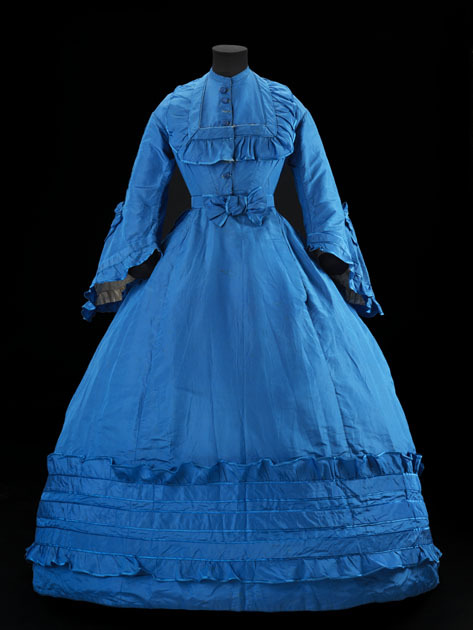

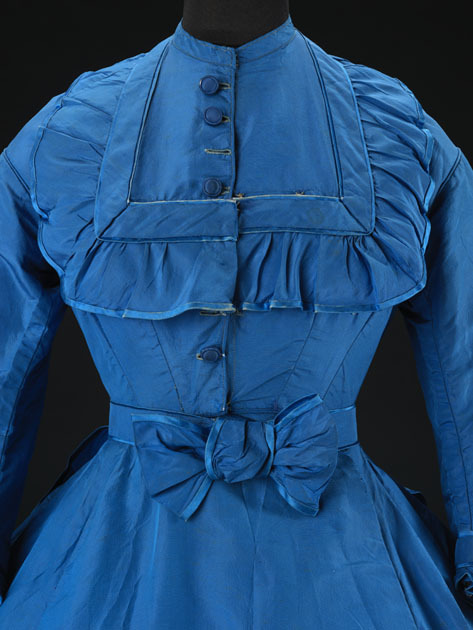
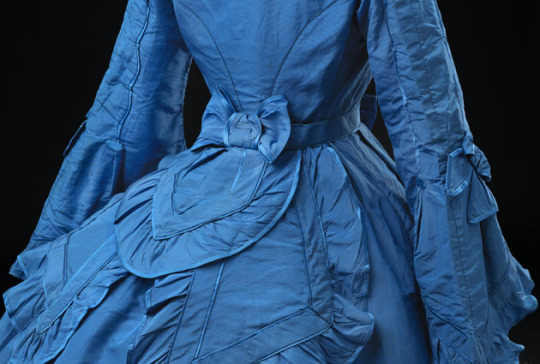
© CSG CIC Glasgow Museums Collection
That is the bluest kind of blue, and given its date (1866-1867) we know it's been dyed with the technologically cutting-edge aniline dyes of the period. As the museum (the Glasgow Museum) notes, some dresses of this era faded with time, but not so in this case.
You can already see the shape of this gown streamlining slightly, the bodice creeping toward the more tailored, masculine styles of the 1870s and 1880s. The monochrome look was very popular at the time, with the then-new House of Worth (who at the time was working with Bobergh). You can see very similar gowns from the duo at the Met, in fact, often in a gorgeous lavender hue.
#fashion history#costume#historical costuming#silk dress#textiles#costume history#threadtalk#victorian fashion#history of fashion
2K notes
·
View notes
Text

The painting: Claude Monet (French, 1848-1928) • Women in the Garden • 1866 • Musée d’Orsay, Paris
The Dress: Day Dress • American • 1862–64 • White cotton piqué with black soutache • The Metropolitan Museum of Art, New York
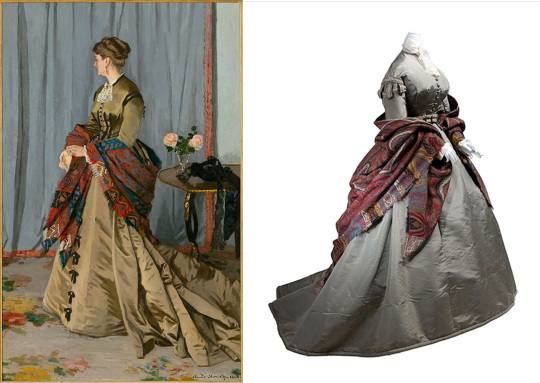
The Painting: Claude Monet (French, 1848-1928) • Portrait of Madame Gaudibert • 1868
The outfit: French ensemble • 1865/67 • Gray silk faille with cashmere shawl from India • Usually worn over the shoulders or in the crook of the arms • Metropolitan Museum of Art
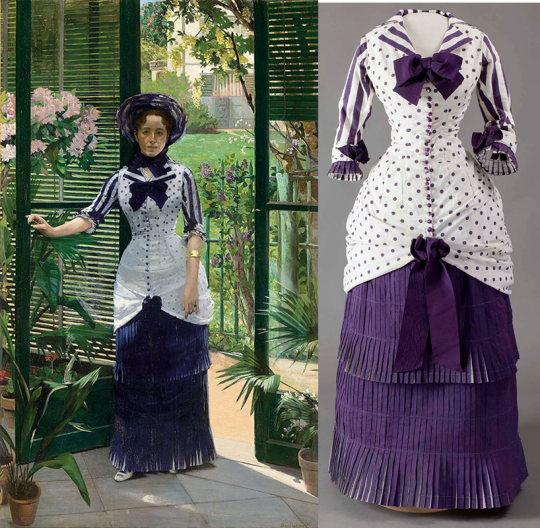
The painting: Paul-Albert Bartholomé (French, 1848-1928) • In the Greenhouse • 1881 (the sitter is Bartholomé's wife)
The dress: Sewn from white cotton printed with purple stripes and dots, this summer gown was made by an unknown French seamstress around 1880.
These three paintings and their companion outfits were part of a large exhibition, Impressionism, Fashion, and Modernity, at The Metropolitan Museum of Art, New York, February, 2013.
#art#painting#art history#impressionism#art exhibitions#fine art#paul-albert bartholomé#claude monet#dresses in paintings#fashion history#historical fashion#historical clothing#19th century women's fashion#the resplendent outfit#art blogs on tumblr#oil painting#the metropolitan museum of art#french artists#museum aesthetic
54 notes
·
View notes
Text
Fashion Showdown: Yellow (Match 9)
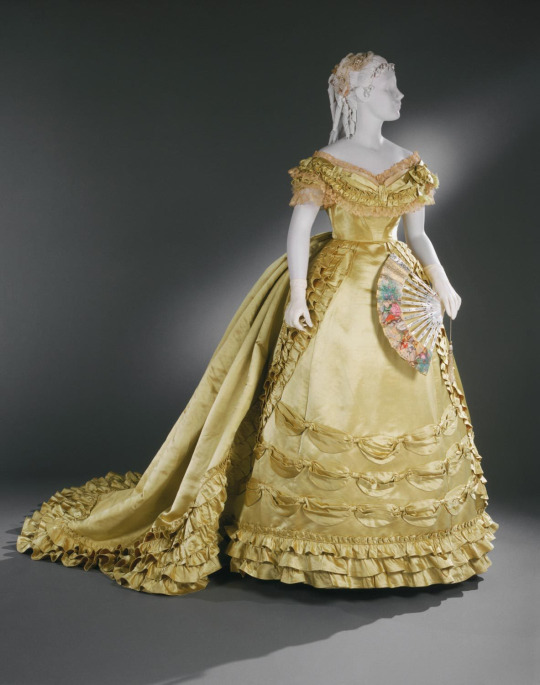
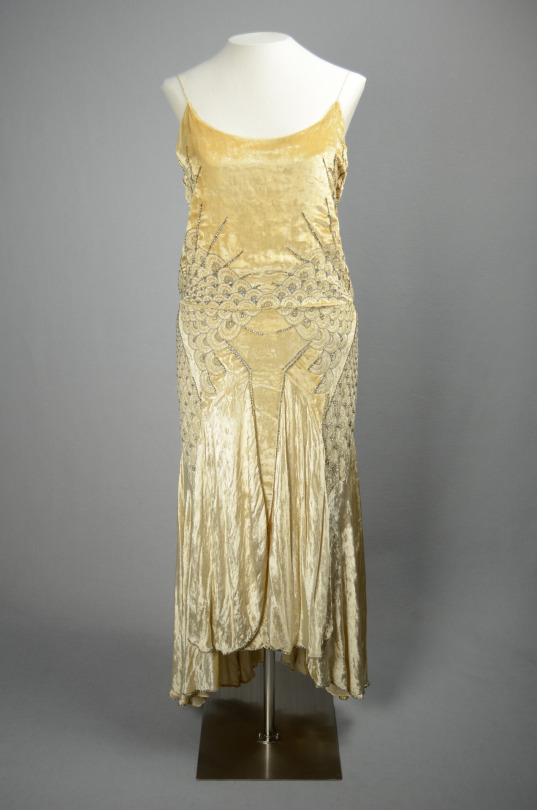
21 notes
·
View notes
Text

John Duncan (British, Scottish – 1866-1945) • Saint Bride • 1913 • National Galleries of Scotland
According to the legend of the Irish Saint Bride she was transported miraculously to Bethlehem to attend the nativity of Christ. Here two angels carry the white robed saint across the sea. The seascape reflects Duncan's fascination with the Outer Hebrides and the Isle of Iona. The birds and seal provide an effective naturalistic foil for the supernatural angels overlapping the patterned border. Scenes from the life of Christ decorate the angel's robes, and may include the artist's self-portrait as the tiny clown (a holy fool) accompanying the procession of the magi on the leading angel's gown. – National Galleries of Scotland
#art#painting#fine art#art history#john duncan#irish legend#lyrical painting#scottish artist#national galleries of scotland#painter#artist#wings in art#artwork#pagan sphinx art blog#art blog#art enthusiast
34 notes
·
View notes
Note
could you please help me figure out when this dress is from? I got it for a christmas gift a couple years ago so i dont know anything about it. My guess is around the 1850s but the sleeves confuse me a bit. It's made of a turquoise silk (it's real antique silk, I just don't know when from) and the dress has the bodice and the skirt attached with a petticoat underneath, that's the little fringe you see at the bottom. The sleeves are about elbow length and the neckline is wide so probably an evening gown. Sorry for the image quality lol.
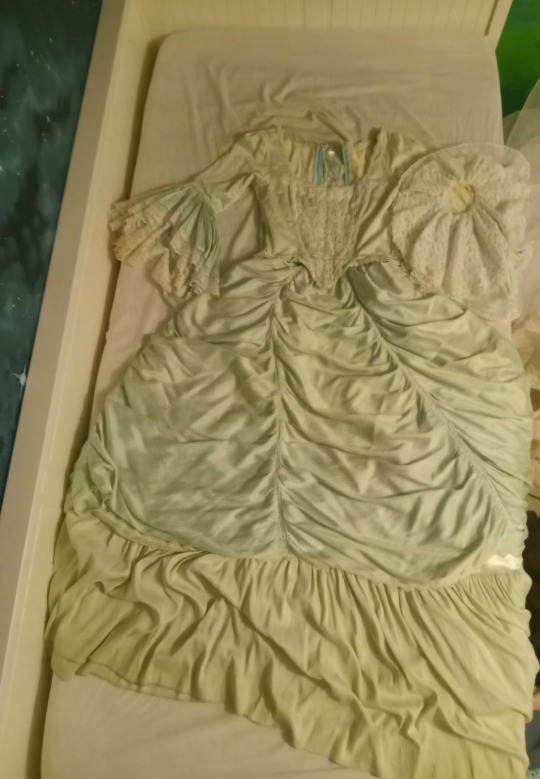
Oh what a nice gift!! If you could take picture of the bodice's insides and maybe even the shape of the side profile of the skirt, I might be able to say with a little more accuracy. Also I'm not experienced at analyzing antique objects or very knowledgeable of that field in general and even if I were, it still would be quite hard to say anything with accuracy without actually seeing the object in person, but I'll do my best with my knowledge on Victorian styles.
Style-wise I think this would most likely be from the first bustle era, so around 1869-1875, or even more fittingly from the couple of years transitional period leading up to it. Rococo Revival was entering the fashion in the transitional period from 1866-1868 in a big way and became a huge trend in the first bustle era, making those Rococo style fitted sleeves with a lot of ruffle at the end very popular. The skirts also had a lot of embellishing with gathering like in your dress and and other types. The skirt though is what makes me think it's rather more fitting of the transitional period, since the skirt doesn't seem to have a bustle, and it's perhaps a little too simple for the bustle era, where the skirts became highly embellished. Skirt of the transitional period was slimming down from the maximum volume it had reached in early 1860s and becoming very a-lined with more length and volume in the back. It was called Princesse style.
Both of the examples are from 1868. The first one is a great example of the Rococo Revival. Unfortunately the Philadelphia museum, in which collection the dress is, didn't have picture of it from the front. The second one has a very similar skirt as your dress.

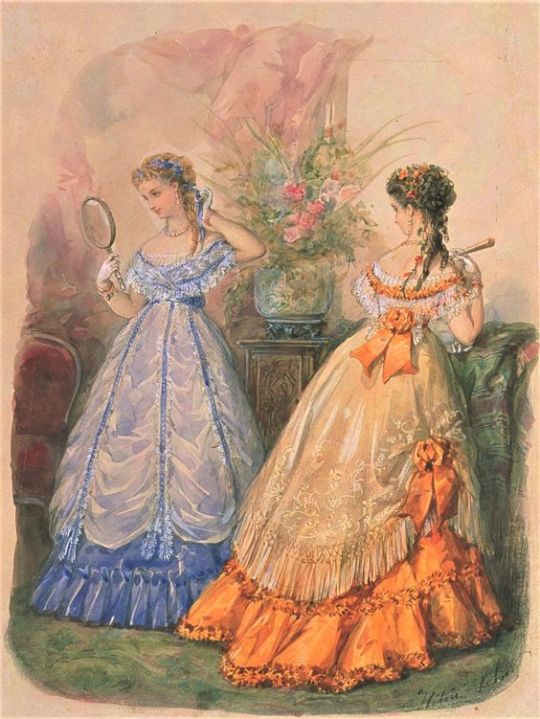
The bodice of the transitional period was very short, perhaps even too short, and examples of bodices with the narrow peak are very few. The narrow peak though is common before those years and fairly common after it. Not all people would anyway follow all the most fashionable trends so precisely, especially when we're talking about a trend of couple of years. The first example here is from 1865 and second from 1869.
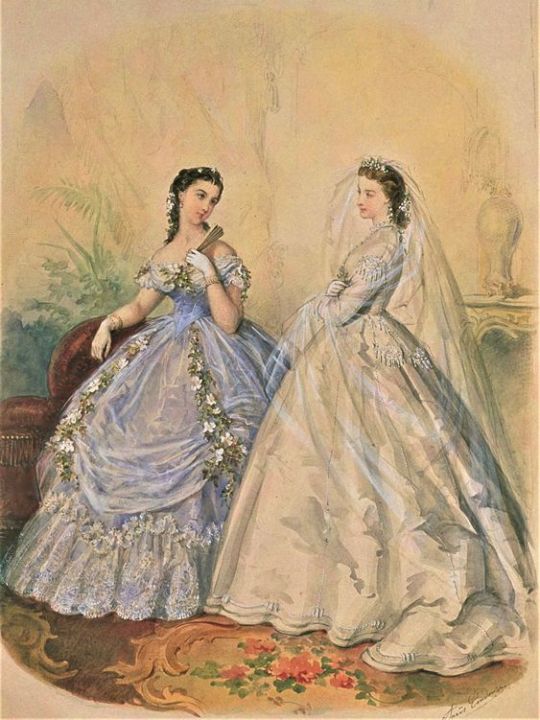

After the first bustle era, the bodices very long in the natural form era and the skirt shape much more narrow. By the second bustle era in 1883-1889 when the bodice became shorter again (though still reaching over the natural waist to emphasize the curve), big Rococo sleeves were very much out of fashion, with only small ruffles in Rococo Revival style dresses.
Before 1866, the skirt was very wide, though narrowing towards it, so I think your dress could fit to 1864-65 too, but it doesn't seem to have enough gathering at the waist for there to be enough volume especially for early 1860s or 1850s. Another issue with dating it earlier into 1860s is that Rococo Revival wasn't yet very fashionable. Gothic Revival, which included Medieval and Renaissance styles, was instead very popular. That's why trumpet sleeves with puffy sleeves under them as a nod to Tudor sleeves (first example from 1863) were very popular in addition to fitted sleeves. Another type of trendy sleeve (more of a nod towards German Renaissance dress) was sleeve with a series of small puffs (second example from 1864). But there was already some early Rococo Revival examples too in early 1860s, like the last example from 1861.
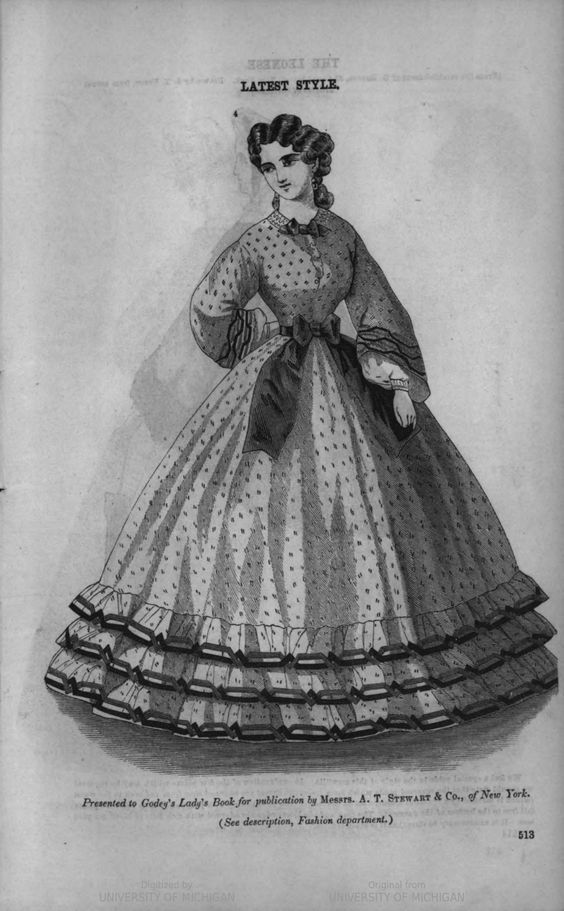

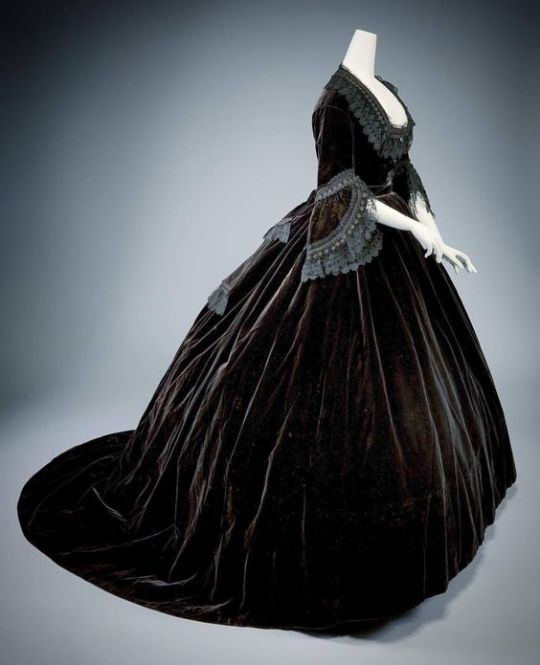
So my best guess would be late 1860s, but I think 1860-1875 is a possibility. I don't think 1850s is probable. It was the peak of Gothic Revival and while I wouldn't be surprised to see a fashion forward example of Rococo Revival at the time, the silhouette of the sleeves was very much voluminous, so I don't think it would appear in a format with fitted upper sleeves. The trumpet sleeves too are at their peak, and would only get subdued for 1860s. The skirt too was very voluminous, and especially round, often having teared look rather than gathered to emphasize the roundness. Here's an example from 1859 and 1867.


62 notes
·
View notes
Text

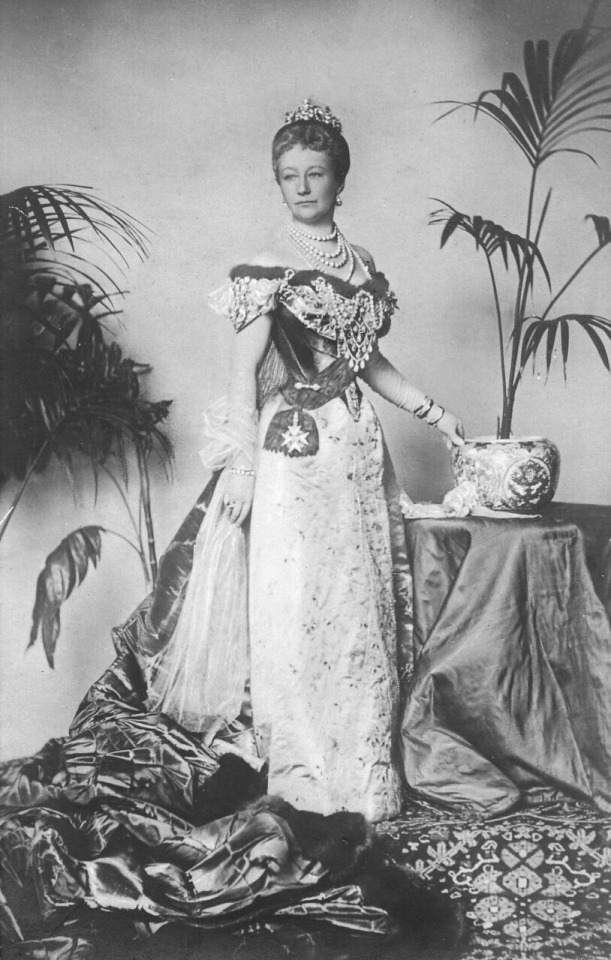
October 22 1858: The Birth of Kaiserin Augusta Victoria of Schleswig-Holstein
Augusta Victoria of Schleswig-Holstein was the eldest daughter of Frederick VIII, Duke of Schleswig-Holstein and Princess Adelheid of Hohenlohe-Lagenburg. Tragedy struck only a week after her birth when her elder brother died from illness. In 1860, her younger sister, Caroline Mathilda, was born. Who was regarded as prettier and a brighter personality than the chubby, serious, submissive Augusta Victoria. Soon Augusta’s mother would give birth to another boy, Gerhard, who died in infancy. Their next male heir and fifth child, Ernst Gunther, was a perfectly healthy baby boy. Augusta would have two other sisters, Louise Sophie in April 1866 and Feodora Adelaide in July 1874.
In her family, she was known affectionately as “Dona.” Augusta’s obedient nature was noted on early in her youth, even by her future mother-in-law Crown Princess Frederick. ‘It is strange how good some children are – and how little trouble they give,’ she wrote to her mother, Queen Victoria, when Augusta Victoria was nine years old. ‘Ada’s children are patterns of obedience, gentleness – the best of dispositions’. (1)
The thought of a match between Princess Augusta Victoria of Schleswig-Holstein and Prince Wilhelm of Prussia was contemplated ever since they were children, as noted by the prince (future Kaiser, ex-Kaiser) later in the future. But was never taken seriously until after the prince was rejected by Princess Elisabeth of Hesse and by Rhine. Perhaps, Wilhelm was seeking for a rebound in Dona and it was a success. As the couple married on the 27th of February 1881. The marriage has been regarded to be happy but not without struggle. As Wilhelm quickly grew bored at his new wife’s longing for a simple domestic lifestyle, having multiple affairs throughout the years. And in the beginning only saw Dona as a broodmare. It was only after an ear infection gone bad, where Augusta stayed by Wilhelm’s side throughout the duration of it did he start to see her in an adjusted light, but continued to be unfaithful to her.
She bore him seven children:
Wilhelm, German Crown Prince, Crown Prince of Prussia (1882-1951)
Prince Eitel Friedrich (1883-1942)
Prince Adalbert (1884-1948)
Prince August Wilhelm (1887-1949)
Prince Oskar (1888-1958)
Prince Joachim (1890-1920)
Princess Viktoria Louise of Prussia (1892-1980)
Her days as Empress, she was regarded by the court as a prudish, a stickler for rules who punished anyone for the simplest gesture she deemed to be “immoral.” She was deemed by many as unremarkable and plain with a gaudy and tacky sense of fashion. With Nicholas II remarking to his mother, the Dowager Empress. That she ‘did her best to be pleasant but looked awful in sumptuous gowns completely lacking in taste; in particular the hats she wore in the evening were frightful.’
Though as overbearing and a nuisance as she was in public life and a part of her private life, by some family members, such as Empress Frederick (with whom she had a very heated feud with and who Augusta enjoyed snubbing frequently) who wrote to her daughter, Sophie, she was characterized as: ‘very grand and stiff and cold and condescending at first, but became much nicer afterwards. Perhaps it was also partly shyness.’ and by her younger sister, Louise Sophie that when she was ‘not bowing to the will of her autocratic husband she was easy and indulgent’. “Her cousin Alice of Albany, who was sometimes mildly critical of her older relations, found her ‘most affable and kind’.”(1)
She was her husband’s biggest supporter throughout everything (for better and for worse) and was crushed when she was stripped of her titles as German Empress and Queen of Prussia after the war. Her health, which was already declining ever since the 1890s (causing her to miscarry twice) went down a rapid decline in the 1920s. And it had worsened when she had heard of the news of the death of her youngest son, Prince Joachim. She passed away on the 11th April 1921, in spite of her personal flaws, she was a beloved Empress by the German people and her popularity outshined her husband’s. Thousands lined up to see her off, where she would be buried at the Temple of Antiquities in the gardens near the New Palais in Postdam. Her husband, the ex Kaiser Wilhelm II was forbidden to cross into Germany to see his wife off for the final time.
Her room in Huis Doorn was soon turned into a shrine dedicated to the late Empress. With Wilhelm ordering for the room to regularly be cleaned with flowers and a cross draped over the bed. “Once a week, for the rest of his twenty years, he would retire there on his own, to go and mourn her memory.“ (1)
Wilhelm adhered to his late wife’s wishes for him to marry someone else when she was gone. When only a year later he would marry Princess Hermine of Reuss. He passed away in June of 1941, at age 82, 20 years after her passing.
Source : The Last German Empress
#monarchy#kaiser wilhelm ii#german empire#german monarchy#imperial germany#wilhelm ii#kaiserin augusta victoria#empress augusta victoria#royal birthdays#THIS TOOK ME AN HOUR😭#and her bday is about to end in 8 minutes#i was hella procrastinating lmao#happy birthday to Dona ig#german royalty#german royal family
25 notes
·
View notes
Note
Did the Duplays really have pictures and busts of Robespierre all over the place ? How reliable are the sources for that?
According to Robespierre (2014) by Hervé Leuwers, the claim that the Duplays had busts and portraits of Robespierre all over the house comes from two memoirs — those of Charles Barbaroux and those of Louis-Marie de La Révellière-Lépeaux:
The next day I was invited to another conference at Robespierre’s house. I was struck by the ornaments at his cabinet: it was a pretty boudoir where his image was repeated in all forms and by all the arts. His painted portrait was on the wall on the right, his engraved one on the left, his bust was at the back and his bas-relief opposite; there were also half a dozen small engravings of Robespierre on the tables.
Mémoires inédits de Pétion, et Mémoires de Buzot et de Barbaroux (1866) page 358-359
I was received very warmly, and ushered into the salon, to which was adjoined a small cabinet whose door remained open. What do I see when I enter? Robespierre, who had impatronized himself in the house, where he received homage such as those paid to a divinity. The small cabinet was particularly dedicated to him. His bust was enshrined there with various ornaments, verses, mottos, etc. The living room itself was furnished with small busts in red and gray terracotta, and lined with portraits of the great man, in pencil, blur, bistre, and watercolor. He himself, well combed and powdered, dressed in the cleanest dressing gown, was spread out in a large armchair, before a table laden with the finest fruits, fresh butter, pure milk and aromatic coffee. The whole family, father, mother and children, tried to guess in his eyes all his desires, in order to instantly please them.
Mémoires de La Révellière-Lépeaux (1895), volume 1, page 114-115
In spite of both these witnesses’ hostility towards Robespierre, their testimonies were nevertheless most likely independent from one another. Though Barbaroux wrote his memoirs between going underground after the Insurrection of May 31 1793 and his execution in June the following year, they weren’t published until 1866, 42 years after La Révellière-Lépeaux’ death (his memoirs were in their turn published 1895). This seemingly destroys the possibility La Révellière-Lépeaux would have gotten the chance to read Barbaroux memoirs and decide to make up he had seen the very same thing.
As far as I get it, the misunderstanding mainly lies in the idea that it was in Robespierre’s own bedroom these busts and portraits served as decoration. That, according to Leuwers, was however first reported not by any contemporary but rather 19th century historian Jules Michelet.
23 notes
·
View notes
Text
Images of 1912 fashion -
Left 1912 (April) Afternoon dress by Beer, Les Modes - photo by Talbot. From les-modes.tumblr.com/page/21 784X1920.
Center 1912 (June issue) Robe d'après-midi par Redfern from Les Modes. From Bibliothèque nationale de France via Wikimedia; fixed spots w Pshop 1453X2265.
Right 1912 (January) Tailored afternoon suit by Linker & Co., Les Modes - photo by Félix. From les-modes.tumblr.com/page/14 705X1920.

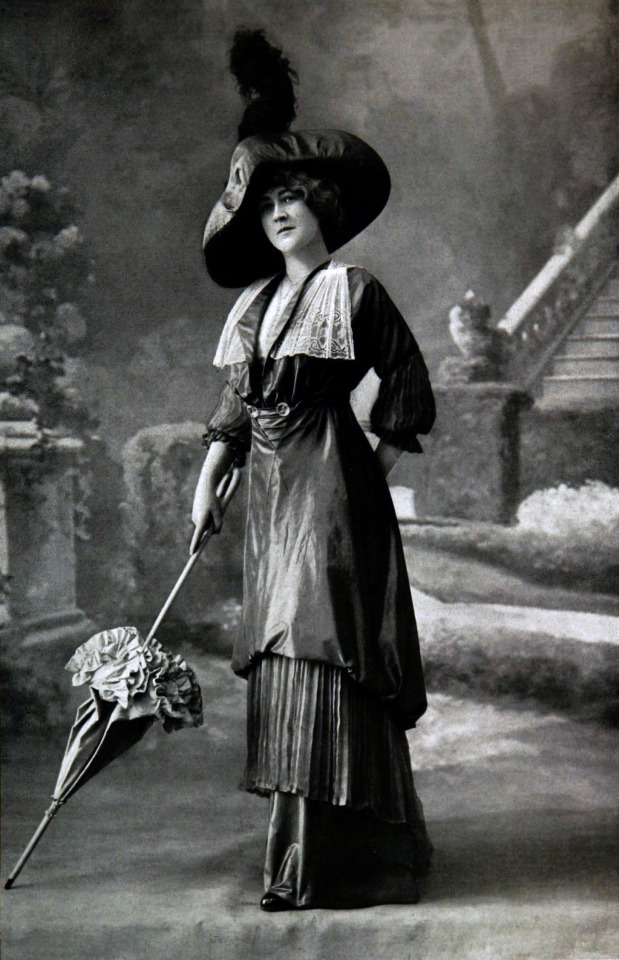
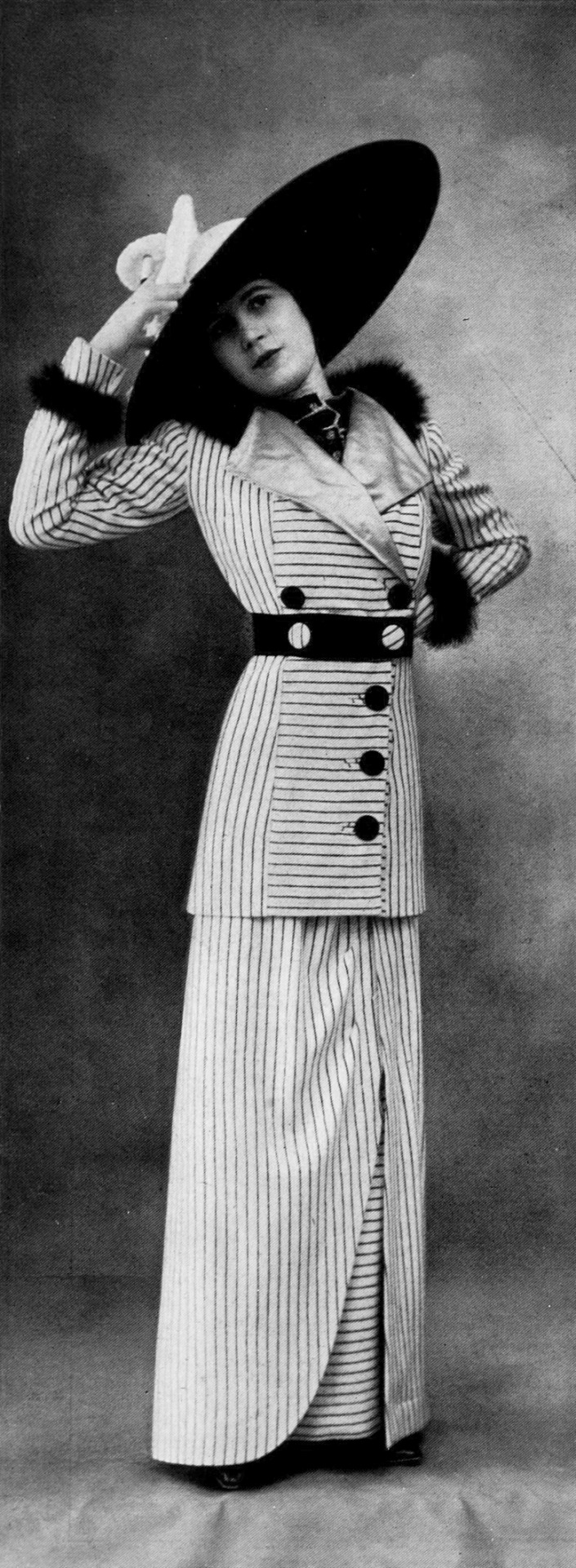
Left 1912 (August issue) Journal des Demoiselles print by A. Baeurlé (Rijksmuseum - Amsterdam, Netherlands). From their Web site 3277X4834.
Right 1912 Journal des Dames et des Modes. From tumblr.com/antiquebee/733887948520652800/journal-des-dames-et-des-modes-1912? 956X1705.

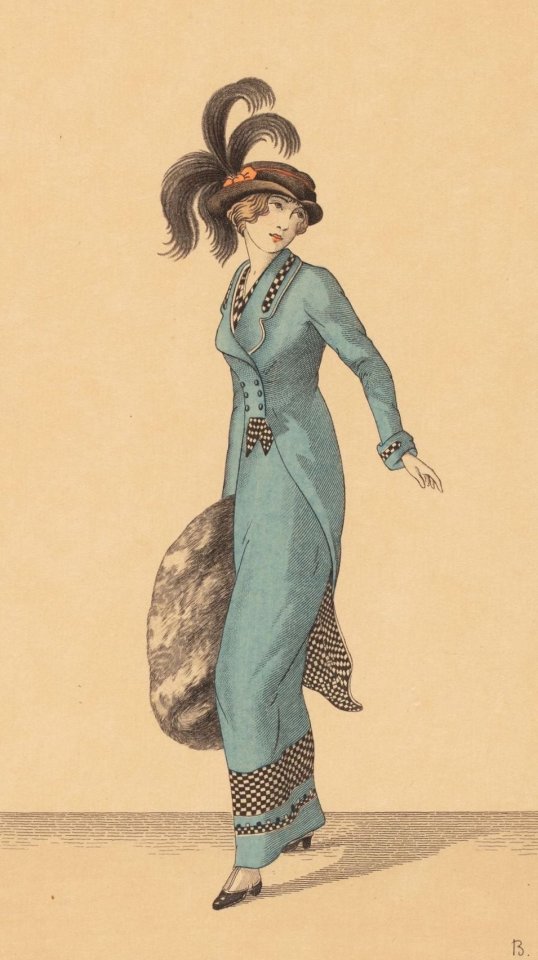
Left 1912 (September) Laferrière evening gown - photo by Félix, Les Modes. From les-modes.tumblr.com/page/10; fixed bigger spots w Pshop 1265X1920.
Right 1912 (September) Lelong evening gown, Les Modes - photo by Talbot. From les-modes.tumblr.com/page/10 1236X1920.

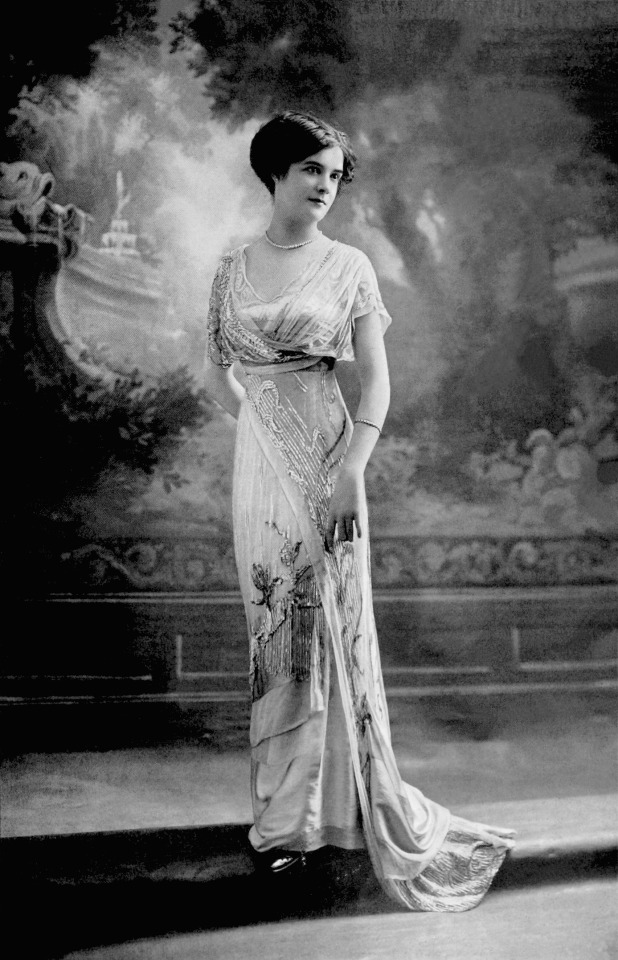
1912 (Winter) Jeanne Paquin evening gown (Helen Larson Historic Fashion Collection, FIDM Museum - Los Angeles, California, USA). From atkinreport.com/2015/07/21/television-academy-fetes-its-costume-design-emmy-nominees/ 1200X1600.

1912 (June) Vita Sackville-West at Ascot cropped 1396X1022
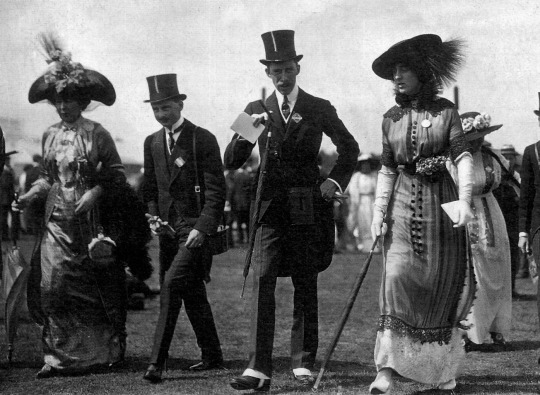
1912 (May) Dresses for the races by J. Dukes, photo by Reutlinger. From castaroundlesmodes.tumblr.com/post/68584847179/my-little-time-machine-dress-for-the-races-by?is_related_post=1 1280X1877.

Left 1912 Afternoon dress by Jeanne Hallée (Metropolitan Museum of Art - New York City, New York, USA). From their Web site 2568X2760.
Right 1912 (September issue) Robe d'après-midi par Redfern from Les Modes. From Bibliothèque nationale de France via Wikimedia; fixed bigger spots w Pshop & trimmed 1334X2118.

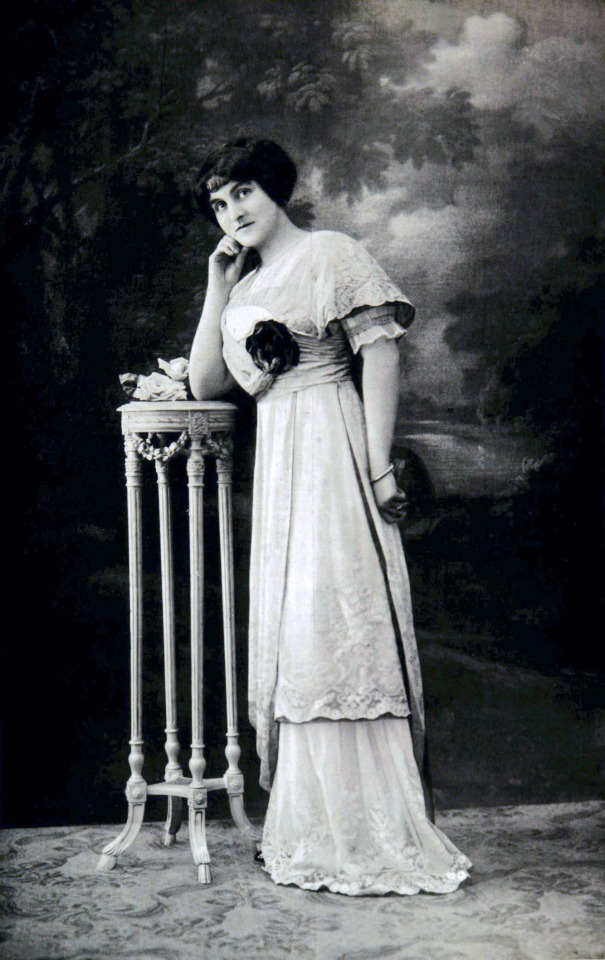
1912 Frieda Countess Logothetti née Baroness Zwiedinek of Südenhorst (1866-1945) by Karel Žádník (Slovácké Muzeum - Uherské Hradiště, Zlin Region Czech Republic). From Wikimedia 2784X3855.

Left 1912 Gustav Beer dress (National Gallery of Victoria - Melbourne, Victoria, Australia). From tumblr.com/lenkaastrelenkaa 1280X1855.
Right 1912 L'Adieu dans la nuit. Robe du soir de Paquin (pl.9, in La Gazette du Bon ton, 1912-1913 n°6) by André-Edouard Marty. From edition-originale.com/en/ 1680X2528.

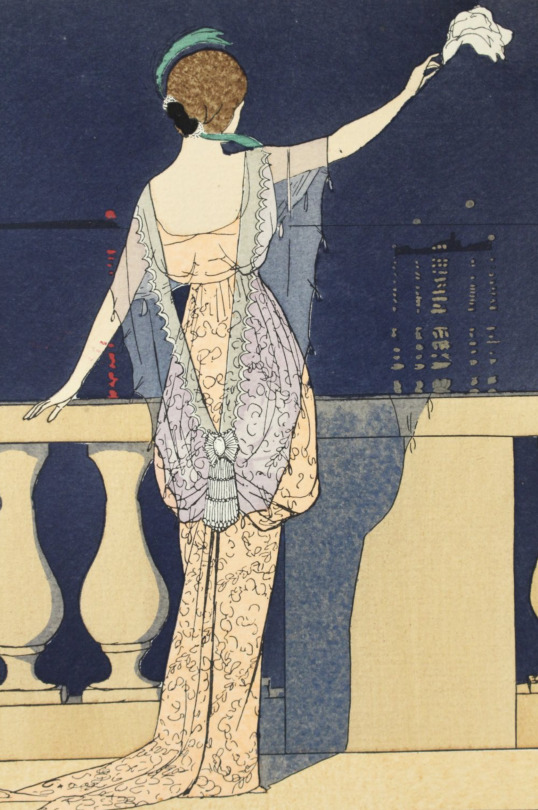
1912 Ladies attending the Henley Regatta in wide-brim hats, a feathered boa and curved-heel shoes. From vogue.co.uk/gallery/style-file-1912?image=5d54889ce144470008e44627 1280X1920.
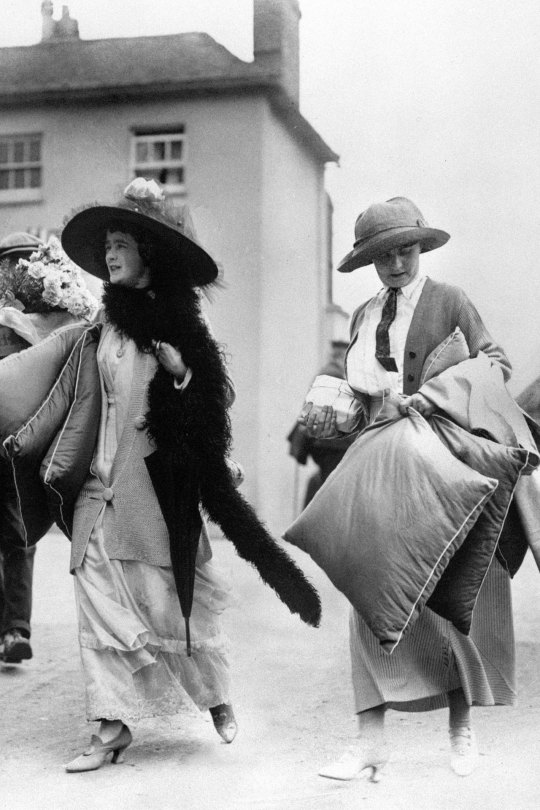
1912 Lady Cynthia Asquith by Bassano front and side 5112X3325.

1912 "Sorbet" by Paul Poiret (Victoria and Albert Museum). From omgthatdress.tumblr.com/page/2490.

#1912 fashion#1910s fashion#Belle Époque fashion#Edwardian fashion#Gustave Beer#Redfern & Sons#William Henry Fox Talbot#Linker & Co.#Félix#A. Baeurlé#Madeleine Laferrière#Lelong#Jeanne Paquin#Vita Sackville-West#J. Dukes#Reutlinger#Jeanne Hallée#Frieda Countess Logothetti#Karel Žádník#Cynthia Asquith#Bassano#Poiret#sorbet dress#flared over-skirt
20 notes
·
View notes
Photo

La Mode illustrée, no. 8, 18 février 1866, Paris. Toilettes de Melles Raboin, r. Nve. des Pts Champs, 67. Coiffures de Mr Croisat, 67 rue de Richelieu. Ville de Paris / Bibliothèque Forney
Description de toilettes:
Toilette de ville ou de patinage. Robe nuance Havane clair, en satin, bordée d'une bande de fourrure, au-dèssus de laquelle deux rubans de velours nacarat, entre-lacés, forment des losanges; jupon de même nuance que la robe, bordé avec un volant nacarat. Sur le corsage montant, retenu par une large ceinture nacarat, veste Figaro, brodée en or et garnie de fourrure; sur chaque côté de la ceinturé poches-aumônières en velours nacarat, brodées de fourrure, et suspendues à des cordons nacarat. Toque russe en velours noir bordée de fourrure.
Robe en gaze de Chambéry, bleue. Jupe très-longue et très- large, bordée d'un volant ayant 40 centimètres de largeur, dans lequel on découpe des dents pointues, ayant chacune trois plis perpendiculaires ; l'intervalle séparant les dents est plissé aussi, mais horizontalement. Ce volant est posé de façon à former une tunique, et le devant de la robe est garni avec deux bouillonnés sur lesquels retombent, de distance en distance, des pendeloques de cristal. Les bouillonnés, comme le volant, sont surmontés d'un entre-deux en blonde blanche; mêmes ornements en cristal sur le volant. Corsage décolleté, très-bas, complété par un corsage décolleté, en mousseline blanche.
—
Town or skating ensemble. Dress in light Havana shade, in satin, edged with a strip of fur, above which two nacarat velvet ribbons, interlaced, form diamond shapes; petticoat in the same shade as the dress, edged with a nacarat flounce. On the high bodice, held by a wide nacarat belt, Figaro jacket, embroidered in gold and trimmed with fur; on each side of the belted purse pockets in nacarat velvet, embroidered with fur, and suspended from nacarat cords. Russian toque in black velvet lined with fur.
Chambéry gauze dress, blue. Very long and very wide skirt, edged with a flounce 40 centimeters wide, in which pointed teeth are cut, each having three perpendicular folds; the interval between the teeth is also pleated, but horizontally. This ruffle is placed in such a way as to form a tunic, and the front of the dress is trimmed with two brothels on which fall, at intervals, crystal pendants. The bubbles, like the ruffle, are surmounted by a white blonde insertion; same crystal ornaments on the flounce. Low-cut bodice, very low, completed by a low-cut bodice, in white muslin.
#la mode illustrée#19th century#1860s#1866#periodical#fashion#fashion plate#color#description#Forney#dress#gown#Modèles de chez#Mademoiselles Rabouin#Monsieur Croisat
73 notes
·
View notes
Note
How did the Victorians/Edwardians approach the matter of skirt lengths/hairstyles for slightly older teenage girls (around 14-15)? I’d assume they weren’t old enough to have their hair completely up with floor/almost floor length dresses, but they must have been too old for shorter dresses and looser hairstyles
This is a great question!
Once the whole "short skirts and loose hair for little girls" thing became common practice, around the 1830s-1840s (I believe), preteens and young teenagers often wore roughly calf-length dresses stylistically in between younger children's clothing and that of adult women. They were more likely to have long hair than very young girls- who sometimes wore theirs short, depending on the specific decade and its trends -and often styled it half-up or in braids. Or just left it loose, sometimes, but that might be less practical for playing or doing chores.

(Unknown adolescent girl, 1860s. Short sleeves for day were sometimes more readily permitted on young girls. Note that her skirt, while long, doesn't reach the floor as an adult's would. Her hair appears to be back in a net, a style of that decade that transcended age boundaries. See also: mention in Little Women of 15-year-old Jo bundling her hair in a net to keep it out of the way, even before she's started wearing "adult clothing.")
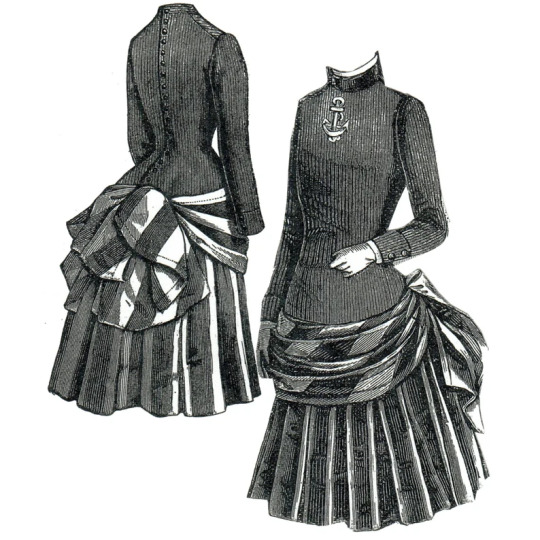
(1885 pattern for a "jersey dress for girl 9-15 years." Sometimes the transition from short skirts to long could be less gradual than the 1860s image would indicate, and a girl might simply wear calf-length dresses from early adolescence until age 16. Within any social norm, you'll get a lot of variation.)
Sometimes you also see charts like this one from various publications:
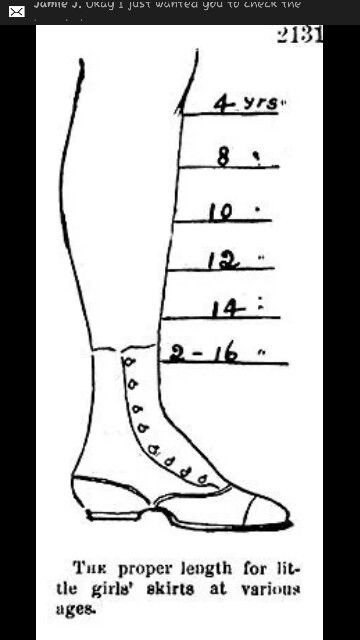
(Godey's Lady's Book, April 1866. The "2-16" indicates that this is the "proper" length for a toddler, who usually wore long gowns regardless of gender, as well as a girl in her mid-teens.)
However, as I mentioned above, you see a lot of variation from decade to decade, and even within those individual decades. Not everyone would have seen a chart like the one pictured, nor held it as gospel. The only real Rule, that I've been able to find, was Girls Under ~16 Wear Shorter Skirts And Looser (Or Shorter) Hair Than Adults. Beyond that, while you generally see teens in skirts below the knee at least, there was a great deal of individual interpretation.
Hope this answers your question!
#ask#eleanorskys#dress history#victorian#edwardian#there were exceptions- adult women could wear short skirts for certain sporting activities or costume parties#and stage performance/modeling allowed for almost any sort of clothing not barred by public indecency laws#(for modeling sometimes even that wasn't an issue)#and there WERE grown women who chose to have short hair for whatever reason so that wasn't#automatically a Juvenile look#but in terms of everyday clothing for the majority of Victorian/Edwardian women and girls? this was The Way
194 notes
·
View notes
Photo

Dressing Gown. ca. 1866. Credit line: Brooklyn Museum Costume Collection at The Metropolitan Museum of Art, Gift of the Brooklyn Museum, 2009; Gift of Mrs. Eloise Phillips Chamberlin, 1969 https://www.metmuseum.org/art/collection/search/174729
#aesthetic#art#abstract art#art museum#art history#The Metropolitan Museum of Art#museum#museum photography#museum aesthetic#dark academia
6 notes
·
View notes
Text
When is ‘Cinderella’ set, anyway?
An unnecessary fashion history dissection of the 1950 Disney film
There are two large obstacles in the way of identifying a particular year.
The first, of course, is that the studio was not particularly concerned with setting the film in a specific year (and in fact had some incentive not to, in order to make the story ‘more timeless’).
The second is that the dress designs, particularly for Cinderella’s enchanted ballgown, were based largely on what was considered fashionable in the late 1940s, when the movie was being made.
The clocktower cannot be used to conclusively date the film, as the oldest clocktower still functioning today dates back to at least 1386 (the St Andrew’s Tower in Chioggia, Italy), and the fashions of the movie appear to be based on fashions of the 1800s.
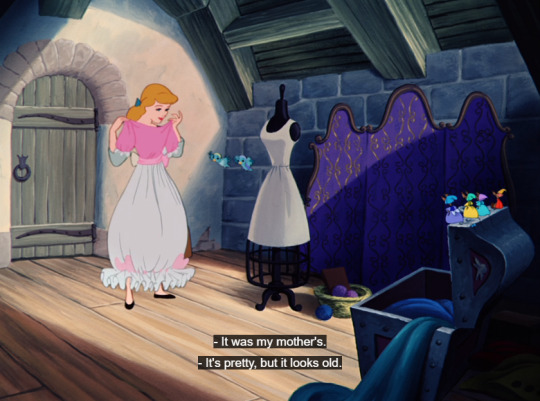
Cinderella’s mother’s dress confuses me, particularly the skirt and how it gathers at the bottom. It looks, to me, like there used to be an overskirt but the material for it has been repurposed, leaving only the underskirt. The puffed shoulders and rounded skirt (almost a bubble skirt), suggest that this silhouette was in fashion when her mother was a young woman and has come back into fashion in Cinderella’s adulthood, as we see sleeve puffs and dome skirts in many other dresses throughout the film.

Assuming we can use the sequels for clues, the story must occur after 1866. There is a sequence in the second movie where Cinderella wears a cage crinoline or ‘hoop skirt’, which was invented in 1856, while the third movie includes the waltz The Blue Danube (da-da-da-da-da, da-da, da-da) which was composed in 1866.
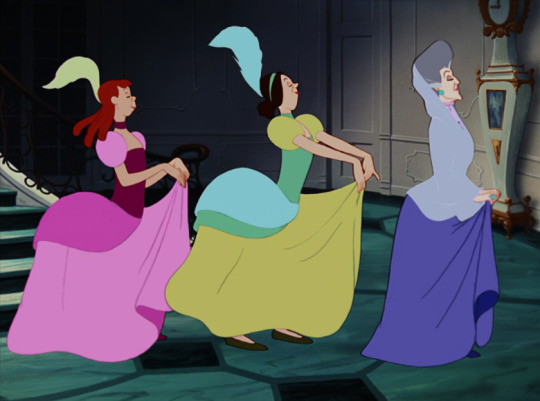
The stepsisters’ ballgowns appear to use shelf bustles, popular in the mid- to late-1880s.

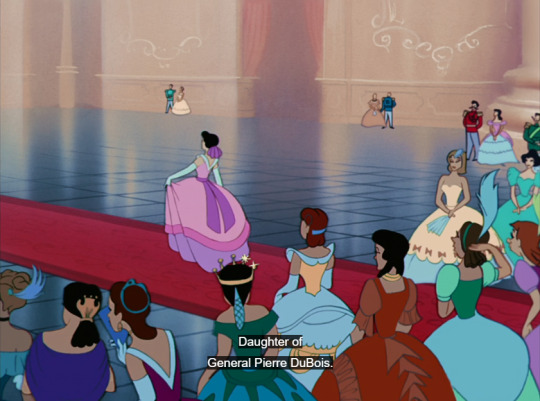



The guests at the ball wear a mix of dome skirts and bustle skirts, suggesting either that bustles are a new fashion or that Drizella and Anastasia’s dresses are slightly out of style.
Supporting the 'new fashion’ interpretation, dome skirts had their heyday in the 1850s and 1860s, prior to what historical costumers typically refer to as the bustle era. It is possible that the dome skirt silhouette has simply lingered in the fashions of the “tiny kingdom [...] rich in romance and tradition” wherein the story is set.
The 'out of style’ interpretation is supported by the dialogue just before the mice steal the sash and beads for Cinderella’s dress. Anastasia declares “I always end up in these old rags,” before throwing her sash to the floor. When the stepsisters are talking over one another while storming out of the room, one of Drizella’s lines that can be picked out is “I don’t see why I can’t have something new!”
Furthermore, part of the opening narration says, “The chateau fell into disrepair, for the family fortunes were squandered upon the vain and selfish stepsisters,” indicating that by the time the main story begins, they are starting to face financial trouble due to living beyond their means in the years before, and thus would not be able to keep up with the latest fashions.
Then there are the sleeves.
Sleeve puffs were popular in the 1830s and 1890s. Lady Tremaine’s regular dress in particular looks like something from 1892 (as the upper sleeves started to inflate) or 1897 (as the puffs were raised more deliberately above the elbow and started to deflate). Her dress for the ball has much more fitted sleeves, with just a slight puff at the shoulder, as one might see at the end of the 1890s or the first few years of the 1900s.
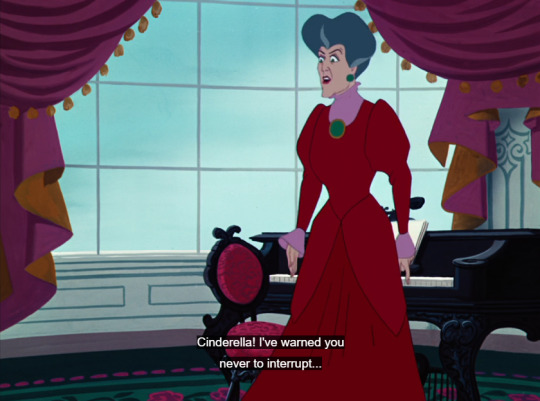

Anastasia and Drizella both wear short sleeves all the time, which were far more common in evening gowns than daily wear.
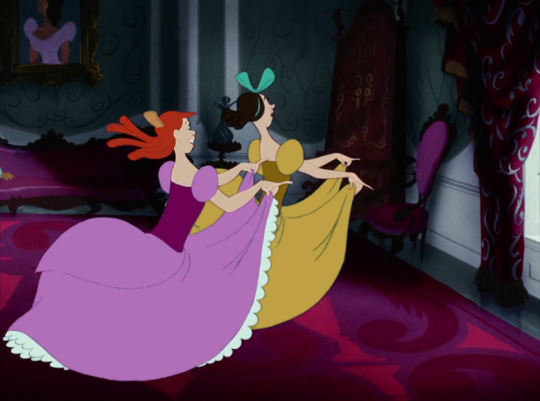
This could be seen as a comment on their vanity and pretentiousness, or as further evidence that the Tremaines are living beyond their means and wear their ‘best clothes’ all the time to conceal how few clothes they own.
The combination of sleeve puff and dome skirt looks like it takes influence from 1830s fashion. The childhood sequence at the opening of the movie shows Cinderella and her stepsisters each wearing dome skirts, Cinderella in puffy sleeves and Drizella and Anastasia in short sleeves with lace cuffs.
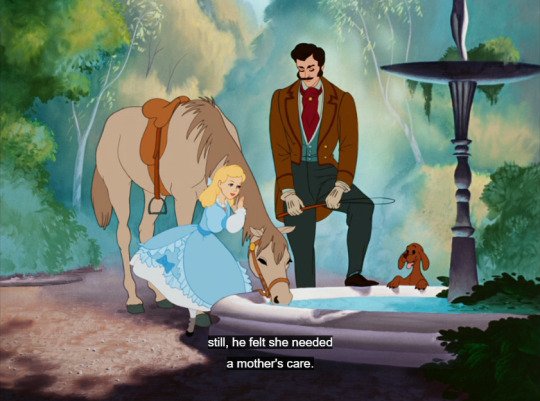

These look very 1830s to me, which implies that, if the bulk of the film is set in the 1860s, the three women are in their thirties or forties. This is in turn unlikely as, if this were the case, some comment would have been made about Anastasia and Drizella still being unmarried at that age. They are more likely to be in their twenties.
(Also, now that I know more about underpinnings, it’s so weird how Anastasia is visibly wearing zero petticoats in the childhood opening scene and yet her skirt still sticks out like that.)
If their childhood garb is in fact the dome skirts of the late 1860s, then the majority of the movie could be set in the 1880s, with the costumers throwing puffed sleeves on a little early. There should, in that time period, be considerably more trims and decoration embellishing each dress, and printed fabric was also fashionable at the time, but this can be explained as a limit of the medium - animators were still having to draw each film cell by hand, after all. This also makes it plausible for Cinderella’s mother’s dress, with its puff sleeves and odd skirt, to be from the 1830s, and perhaps having lost some pieces over time.
7 notes
·
View notes
Text
Olympe Boisse, Reception Gown, ca. 1866-67. FIDM Museum.
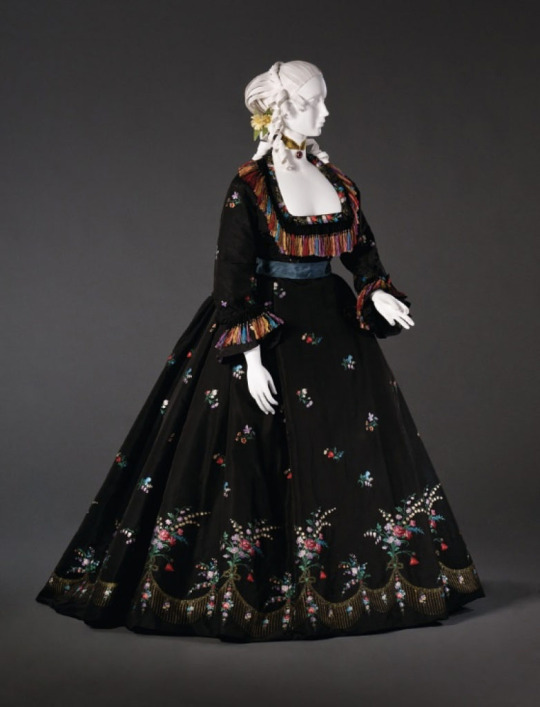
19 notes
·
View notes
Text
Victorian Era
Aesthetic Movement
In the mid-victorian era 1870-1880 a group of talented artists, poets, writers and some actors were known as the Aesthetes.
The Aesthetics views on the dress was influenced by artists such as Dante Gabrielle Rossetti and William Morris and their circle. Artists like these had began to take interest in fashion as an improvement area of study and design. They preferred flowing form and fabric over the traditional Victorian corseted silhouette, they took inspiration from classical, medieval and Renaissance periods. They then began to design dresses which were initially intended to be worn as costumes for sitters whilst paintings, this gradually filtered through to more women.
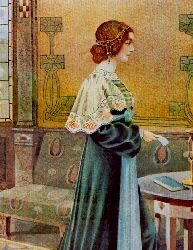

Karin Mckechnie-Lid. (2021). In The Works - Tea Gowns Part 2. [Online]. lilyabsinthe.com. Last Updated: 31 August 2021. Available at: https://lilyabsinthe.com/tag/aesthetic-dress/ [Accessed 2 January 2023].
Admim. (2022). The Aesthetics Fashion History. [Online]. fashion-era.com. Last Updated: 24 January 2023. Available at: https://fashion-era.com/aesthetics.htm [Accessed 2 January 2023].
The Aesthetic fashion was a looser cut and was unstructured with movement, the garments had larger sleeves coming from the style of medieval or Renaissance garments. Many elements also came from Greek, Roman Gothic, Georgian, Far East, Middle East and Japanese styles.
Dante Gabriel Rossetti
Rossetti was the original founds of Pre-Raphaelites Brotherhood who lead a colourful life and created beautiful art. His paintings were intensely spiritual pictures one of his wife who died in 1862, the bird in the painting is a messenger of death carrying a poppy, twin figures are Dante and love in the background, Beatrix has her eyes closed and her face looking upwards as if she is in a trance, a sundial marking 9 o’clock the hour of her death, the poppy is also a symbol of death.
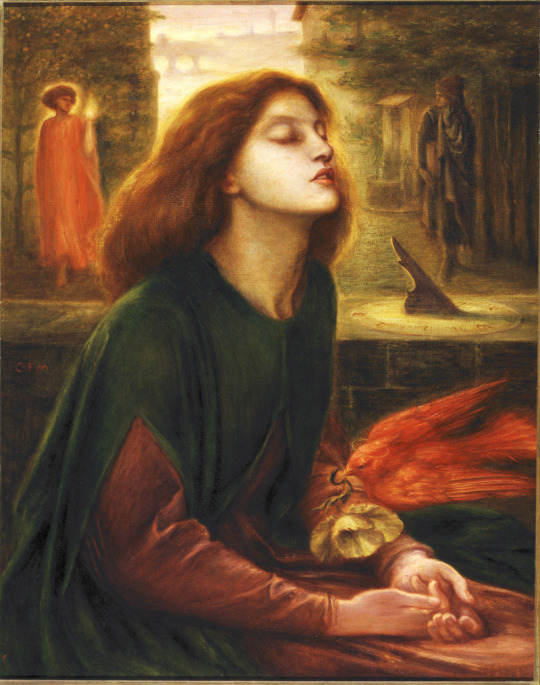
Beata Beatrix 1864-70
(Tate Gallery London)
Elton Luz. (2023). Beata Beatrix. [Online]. www.wikiart.org. Last Updated: 29 April 2022. Available at: https://www.wikiart.org/en/dante-gabriel-rossetti/beata-beatrix-1880 [Accessed 2 January 2023].
Monna Vanna 1866

This is one of Rossettis portrait of Alexa Wilding a model he found on the streets, Rossetti considered this one of his finest works and he never surpassed it .
3 notes
·
View notes